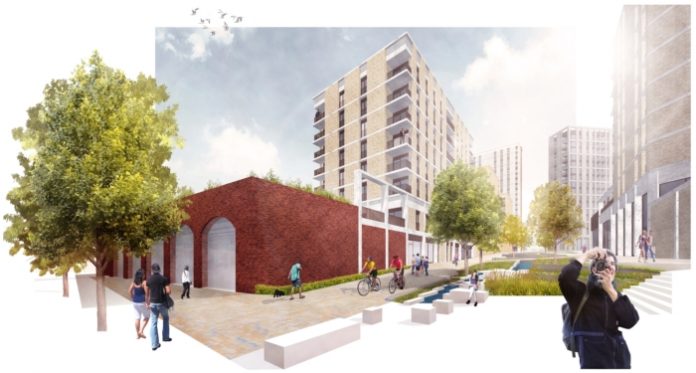Plans to transform Glasgow’s High Street area by investing £200m in a new 7.5 acre mixed-use development have been submitted to Glasgow City Council.
In addition to 727 new build-to-rent homes on the site behind High Street rail station, the application proposes a new public square, as well as 99 student studios and circa 3,365 sq m of retail, leisure, food, drink and commercial business space. For the first time, the area will be opened up through new tree-lined access routes, connecting the Merchant City through High Street and into the East End.
The area was the original location of Glasgow University, the Hunterian Museum and later became the goods yard of the City of Glasgow Union Railway Company. The Molendinar Burn, the original freshwater source upon which Glasgow was founded, also passes underneath the site. However, other than a small section currently used as a car park, the site has lain empty and derelict for many years.
The bold new vision to bring the site back to life has been put together by Get Living, the UK’s leading large scale residential investor and owner-operator of the former London 2012 Athletes’ Village, now known as East Village. The multi-million pound investment in Glasgow is the company’s first venture outside of London.
Following public consultations with the local community, the outline planning consent granted to the previous site owner has been reconfigured to create a truly residential-led and green neighbourhood, including new public amenities and access routes.
Glasgow-based architects Stallan-Brand, who have worked on major development projects in the city including the 2014 Commonwealth Games Athletes’ Village and Tron Theatre, drew up the plans alongside internationally-renowned urban landscape designers Martha Schwartz Partners (MSP) to create inspiring and sustainable public areas through the site.
Get Living is the most established operator in the UK’s Build to Rent sector and currently rents more than 1,900 homes across two London neighbourhoods; East Village E20 and Elephant Central in Elephant and Castle. Build-to-Rent homes are designed specifically for renting and are professionally managed. Build to Rent neighbourhoods can help alleviate housing shortages in city centres, with properties typically brought to the market and occupied more quickly than for-sale developments.
Rick de Blaby, Executive Deputy Chairman, Get Living said:
“The housing shortage in the UK needs no introduction and we know from our own research that there is a demand for high quality and professionally-managed rental homes in safe, well-maintained neighbourhoods.
“Our £200million proposal is a significant investment for Get Living and commits us fully to the long-term growth and success of Glasgow. Our role will see us working alongside the Council and its own ambitious plans for the city, alongside businesses that need to recruit and retain staff and most importantly for the people of Glasgow to deliver great homes set within new public spaces.
“We have listened carefully to local people, then worked very hard to create these ambitious plans for a new green neighbourhood in the heart of the city. This is a historic site and we are keen to see it become a thriving part of Glasgow’s future.”
Get Living CEO, Neil Young, added:
“We believe this new neighbourhood at High Street will be an ideal fit for this part of the city and bring what is currently an invisible site back to life.
“People who want to live and work in central Glasgow, from NHS employees, IT and financial services specialists to university staff, will be able to rent a home with award-winning customer service, from a landlord they can call on seven days a week. Residents and the neighbouring community will also have a diverse range of retail, commercial and leisure outlets right on their doorstep that will complement the existing High Street area.
“We commit to our neighbourhoods for the long term, building vibrant, safe and well-managed places to live. More than 3,000 people now rent from us in East Village and, since we launched in 2013, we’ve helped foster a strong sense of community by supporting independent retailers, funding grassroots clubs and hosting free events. We are committed to bringing this neighbourhood-focused approach to Glasgow.”
Subject to planning consent being granted, work on site would start in late 2018.



















